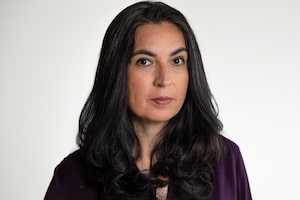Growing up, I never felt Native enough. My father was Polish-Canadian and my mother was raised on the traditional territory of Fort William First Nation. She did not stay in her community or in Thunder Bay; she left and eventually settled in Toronto.
I was born in Scarborough, Ont. I’ve never really moved from this city of glass and steel, of concrete sidewalks and streets full of people with wild and diverse backgrounds. People used to ask me if I was Italian, Greek or Spanish. When I told them I was Polish and Ojibwe, most would chalk that up as an interesting detail, having no clue what being Ojibwe meant: that part of me was literally from the lands, rivers and trees that built this modern nation of Canada.
Growing up disconnected from where my mother was from, I looked up to Indigenous people I saw on TV, including Duke Redbird, from Saugeen Ojibway Nation, who was a reporter for CityTV. It’s part of how I found a sense of belonging.
Then there was Buffy Sainte-Marie. I saw her on TV specials and listened to her music. She was so beautiful, so natural and authentic, with her feathers, long hair and leather. The way she sang and moved and breathed energy into all she did – here was a Cree woman, belting out her truths, our truths.
But a recent investigation by the CBC’s Fifth Estate casts doubt on who Buffy purports to be.
Among all the revelations in the story, perhaps the worst part is her claimed connection to the Sixties Scoop. In the past, she has said that she was taken away from Indigenous birth parents and raised by others. This connected with me: My mother was raised by her grandparents, her three brothers having been placed in the foster system and raised by others. My late sister was adopted out and raised in Manitoba. But the CBC found a birth certificate that said Buffy was born to an Italian-American family.
So many Indigenous people still have family members returning to us, and we are all still putting together the pieces of who we are. Our families have all been touched by intergenerational trauma brought on by colonial violence aimed at keeping us apart – by residential schools, the Sixties Scoop and the Indian Act, a racist and sexist piece of legislation that lets the Canadian government determine who is and isn’t Indian. Until 1985, generations of women had their Indian status taken away both legally and in the community through enfranchisement, just for marrying non-Indians.
So it is a lifelong engagement, meeting with intimate strangers, sharing blood but also searching for belonging to ourselves and our communities. It is not easy. But this is the reality of being a First Nations person in Canada.
This is changing, thanks to the hard work of real First Nations women who fought for our families: Mary Two-Axe Earley, Sandra Lovelace, Lynn Gehl, Jeannette Corbiere Lavell, Yvonne Bedard, Sharon McIvor, Cindy Blackstock – these women are the heroes we should be celebrating. Pretenders make a mockery of the belonging they fought for.
The very act of someone claiming to be something they have no real clue about makes me shake with anger. I am a Status Indian under the Indian Act – rights that my ancestors and First Nations women fought for. My community is Fort William First Nation.
What’s more, those who pretend to be Indigenous distract from what really matters: the emergencies in our communities. This past weekend, Elaina Cecilia Nancy Beardy, an 11-year-old girl from Kingfisher Lake First Nation, died by suicide. “Elaina was always a happy young lady, always had a ready smile for everyone,” the news release from Kingfisher reads. “Princess Elaina will be forever missed and will forever be in our hearts.”
What prompts an 11-year-old to take her own life? Why is this not the top news story in Canada right now?
We cannot let Buffy Sainte-Marie distract from Princess Elaina. Buffy might have been an icon – an advocate, a staunch ally and a passionate educator – but at the end of the day, she was an entertainer first.
Indigenous identity is complicated. Buffy was traditionally adopted by a Piapot First Nation family in her 20s, and I respect that. And everyone is entitled to their own thoughts about what the Fifth Estate revealed. I do not judge which side of the fence you are on – this is Indian country. But this must not distract and divide us. We have been divided enough.
There is so much hurt right now, and we in our loving and accepting nations should be throwing our arms around one another, talking through the wounds opened by Buffy’s story. We need to find connection with each other.
 Tanya Talaga
Tanya Talaga